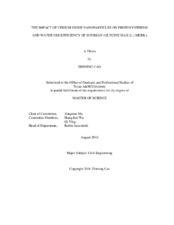| dc.description.abstract | The widespread industrial uses of cerium oxide nanoparticles (CeO2 NPs) and their unregulated disposal have raised increasing concerns about the consequences of these nanoparticles on the environmental health and safety. Previous studies on the interactions between CeO2 NPs and plants reported inconsistent conclusions of CeO2 NPs toxicity on various species. While many previous research have demonstrated the impacts of CeO2 NPs on the physiological, biochemical and genetic processes, detailed understanding on the effects of CeO2 NPs on plant photosynthesis in still elusive. There has also no study which investigated the impact of CeO2 NPs on plant water use efficiency (WUE), a key parameter for crop yield. Therefore, this research aimed to provide new insights into the impact of CeO2 NPs with different surface properties (uncoated and polyvinylpyrrolidone (PVP)-coated) on plant photosynthesis and WUE at various soil moisture contents. The concentration of CeO2 NPs ranged from 0-500 mg/kg dry soil and the soil moisture content ranged from 55-100% θfc. WUE was estimated by measuring δ13C of soybean tissues and photosynthesis was thoroughly studied by characterizing photosynthetic response curve with respect to varying photon intensities and CO2 concentrations.
CeO2 NPs exhibited hermetic effect on soybean that positive impact was observed on the soybean at 100 mg/kg while significant inhibition was shown at the highest concentration of (500 mg/kg) at water sufficient condition (100% θfc). The results also indicated that both types of CeO2 NPs at the concentration of 100 mg/kg soil stimulated the growth and consistently enhanced the photosynthesis and WUE of the soybean during the 3-week treatment. Our results also indicated that the enhancive effect of CeO2 NPs on plant photosynthesis and WUE was dependent upon the soil moisture content. While both types of CeO2 NPs exhibited consistently positive impact on the photosynthetic performance of the soybeans at the moisture content of 70%, 85% and 100% θfc, CeO2 NPs did not enhance the photosynthesis efficiency of the soybeans at 55% θfc, which suggested that the positive effect of CeO2 NPs was limited by the soil moisture deficiency. Further examination of the results suggested that Vcmax (maximum carboxylation rate) was affected by CeO2 NPs, indicating that CeO2 NPs affected the Rubisco activity which governs carbon assimilation in the dark reactions of photosynthesis. In conclusion, CeO2 NPs demonstrated significant impacts on the photosynthesis and WUE of soybeans and such impacts were affected by the surface properties of CeO2 NPs, the concentrations and the environmental conditions. | en |


